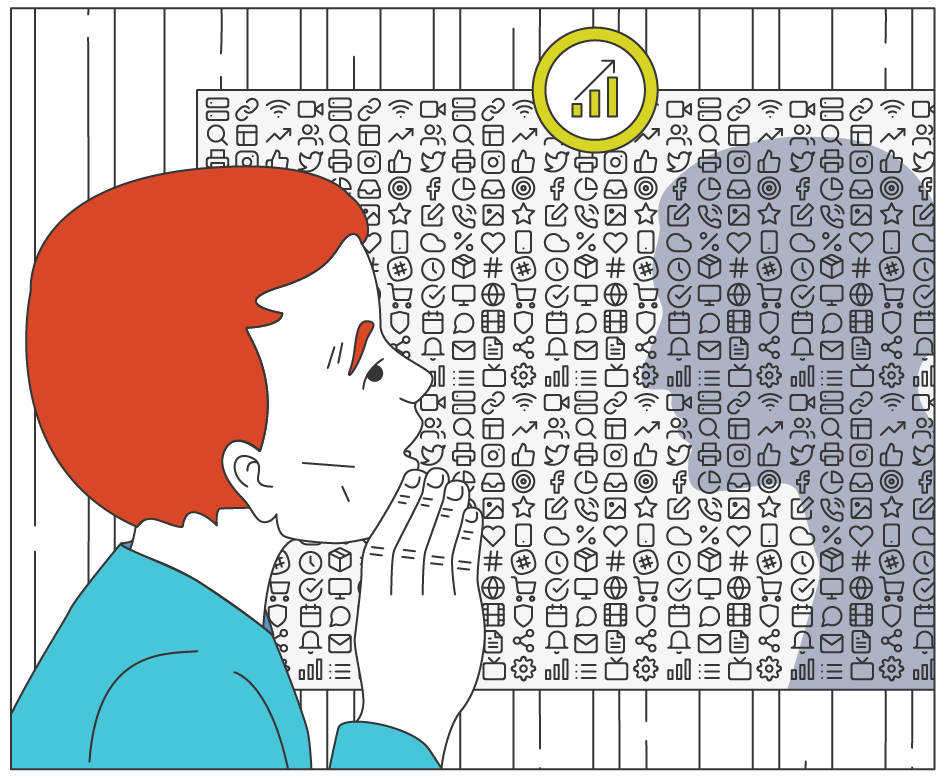I have no idea what most B2B companies actually do.

Welcome to Episode 02 of our Modern Marketing Confessional series. The purpose of the series to to give voice to marketers who have a strong opinion to share, but lack a forum in which to say it. Think griping, in more erudite terms. If you are new to the series, check out Episode 01: I Hate The Customer Journey.
What does your company do?
No seriously. What do you guys do? I just checked your website, and I have no f@#king idea.
It looks like your modern enterprise offers “solutions”, “ROI” and “efficiency.” What a coincidence that so many large companies seem to do the exact same thing.
Except, you don’t. I bet you provide specific products and services to a select audience, who are suffering from a set of problems that you are uniquely qualified to solve. But I sure didn’t read that.
Can you imagine how hard it is these days to be a decision maker at a large company, trying to solve a problem, identify the right solution, and narrow down their short list of truly qualified vendors?
“Oh, good. This company also provides “growth” and “agility.” That’s just what we need to solve this extremely specific problem! You know, just the other day our COO burst into my office and said, ‘Baxter, get on the type-box and Google us up some agility, will you?’”
Have you ever read research that cites “word-of-mouth”, “peer referral” and “social proof” as the most influential sources of evidence in a purchase decision?
Maybe, just maybe, that’s because 90% of your prospects, aren’t ready to deal with a salesperson; going directly to a vendor website to learn more leaves you with a head full of questions and an inexplicable urge to point at whiteboards. It’s understandable that you’d have to rely on a human you trust for any sense of who’s good at solving the problems you have.
How did this happen? When did companies stop making sense?
I think a few possible culprits might be to blame.
Culprit 1: Disconnected dots
What’s the brand essence of Apple? We could play a word association game, but ultimately, most of us are going to reach a similar conclusion: Apple seems to just reek of cleanliness, simplicity, design, and innovation. How did Apple achieve this? Short answer: not easily.
What Apple understands is that in order to pay off a brand essence—something that triggers an emotional and therefore almost irrational first impression, and carry it through and make it real—you have to connect a ton of dots.
“Dots…” I know. It’s vague. Let’s dispense with the fluff, yeah?
Apple decided long ago the emotional impact it wanted its brand to make. They made sure they had a look and feel and identity that conveyed it. And this is where too many companies stop (back to this in a bit).
Apple then understood that it wasn’t just their website home page and billboards that had to convey that message; it needed to carry through their products, their packaging, their customer experience across digital and retail channels, technical support, everywhere.
Needless to say, this is a ton of work. How do you make a customer feel like they are experiencing an innovative (and thus Apple-esque) shopping experience? Change the retail experience completely. That’s how. Make it sparse, clean. Make them feel like they just walked out of a time machine that sent them a couple decades into the future. This is just one example of how you take your essence and carry it through.
So what are so many companies missing here? It’s the follow-through. It’s brand essence, connected to value proposition, connected to messaging pillars, connected to a strong go-to-market framework and audience definition, and finally, all the way into your campaign assets, your product messaging, your product, your customer experience, etc.
Without the follow-through, you get all essence and no substance. You get foundationless fluff.
I spoke with Ardath Albee about this recently, and here’s what she had to say:
“The problem most companies have with even defining (redefining) their “essence” is that it’s done somewhere away from the masses, decided by a select few and then communicated badly. TWEET THIS
You wouldn’t believe how many clients I’ve worked with who suddenly forwarded the new brand values slide deck their corporate comms department and branding agency just rolled out—without notice.
This brings all projects to a screeching halt as everyone shuffles madly to regroup, trying their best to force existing messaging into alignment with the “new” values and brand definition. Or, even worse, disparate teams go ahead with what they had in progress, even if the message is now in total conflict with the new brand strategy. This is how companies end up without strategic follow-through. It happens a lot. The end result–an even more confused audience.”
Culprit 2: B2B is faking it until it makes it…and it hasn’t made it yet
Business-to-business organizations didn’t always have to compete with the creative ideas of, say, Coca-Cola. Buying for a business was thought to be a hyper rational endeavor. That’s because, until recently, we didn’t have campaign metrics to prove otherwise. Once that sacred cow went to slaughter, after engagement took a dive and people started tuning out, companies had to start taking the notion of “engagement” seriously.
In the last decade, B2B companies have begun to realize that they are selling to humans, and so they’re ready to embrace more creative ways to engage their audiences. TWEET THIS
But many B2B marketers are new to this. Even scared of it. And, honestly, they just don’t know how to do it. So they fake it.
So how does a company fake creativity. I wrestled with how to frame this up, but I think no one hits the nail on the head better than Dr. Ian Malcolm in Jurassic Park:
Get it? For some businesses, they’re in the early stages of trying to be creative. They associate “creativity” with stock images of the mountains enveloped in fog, or a busy highway interchange or, again, struggling actors pointing at gibberish written on a whiteboard. They use punchy platitudes and metaphors. It has the scent of creativity, but there’s no meat.
As users, we fully expect to land on a website for a company that does tax software and see a panoramic image of an airplane hangar. Why? Because something about precision, we think.
These newbies are trying to inch their ways into the creative space. It’s admirable. They’ll get there. But in the meantime, it’s contributing to a serious case of the WTFs because most of those images and language don’t mean anything.
I spoke with fellow industry thought leader, Carlos Hidalgo, about this very topic, and this is his two-cents:
“I believe we are moving past the point of faking it and many organizations have come to drink their own internal Kool-Aid—meaning that they have taken it upon themselves to inform their own hypothesis and “facts” about their customers.
Recently, a study came out where marketers made the claim that their buyers are interacting with them early in their buying cycle. Really? Is this customer informed or a marketing pipe dream? We have to get to actually doing the hard work of collecting customer insights and letting our creativity and engagement flow from that insight. The more we buy into our false sense of internal insights, the more distance we create between activity and outcomes.
Culprit 3: Lacking Validation
People living outside of the machinery that creates corporate messaging would be shocked to learn how much of that work is based on insular opinions. In the ecosystem of messaging there are three classes:
- The message you want your audience to care about
- The message you think your audience cares about
- The message your audience proves it cares about by way of engagement or lack thereof
There exists entire messaging architectures that are based solely off #1.
I’m not saying #1 is a dead end. You need to know that. But you also have to hypothesize what your audience cares about. Then, you have to actually test it and validate it.
Basically, you need all three classes in your ecosystem for it to be healthy. And when #1 goes unchecked, you have an invasive species on your hand. It’s remarkable how much damage this does to your marketing, sales, and customer success functions.
A fellow industry expert, Matt Heinz, told me this:
“The closer you are to your customer, the better your messaging will naturally be. It’s honestly that simple. TWEET THIS
B2B companies with obtuse messaging too often are living in their own heads, guessing or inferring what their customers want. Some companies start with solid customer intelligence but fail to keep a daily pulse on that external voice. The more you start to believe you know what your customer needs, what they think, the more likely your messaging will fail to communicate clarity and value to them as well.
The solution? Make customer intimacy a core competence of your business at every level. Develop deep, multi-dimensional customer personas and maps of the entire buying committee–not just each member but how they relate to each other, how they build consensus, where they differ, etc. Understand more than just how they talk, get to know what they feel. What they value. What they fear.
The deeper this understanding exists within your organization, the stronger and more impactful your messaging will be.”
Culprit 4: The Illusion of Safety
People like metaphors and platitudes. What better way to say something without actually saying it.
I’m not sure when the overriding priority for businesses became to avoid offending anyone, but it seems to be a heavily adopted messaging strategy. Not enough people do the homework to develop a real insight that cuts. Not enough people do the sometimes-scary work of developing a true point of view. No one has the courage to take a stand for fear that a prospect, or a Vice President of Something, might disagree.
I tend to have to make this point a lot as a Creative Director, but brands are rarely choosing between a happy audience and an angry audience. In many cases, the choice is between an audience that’s paying attention or not.
And you’d be surprised what people tune in to, even if they disagree with what you’re saying.
But the fear is real, and that’s yet another reason why brands speak in sweeping generalities and platitudes. In an effort to speak to everyone, they aren’t really talking to anyone at all.
Ardath Albee weighed in on this too:
“This is a root problem. By failing to fearlessly put a stake in the ground, you’re actually, as Theo says, engaging no one. At least not with any depth of resonance. B2B buyers are looking for expertise that brings value to them.
If you’re known as a generalist because you’ve failed to claim your niche, you’ll find it exceedingly hard to build trusted relationships with your audience. What should they trust you will bring that’s valuable to them? Defining that is what makes companies the go-to for something buyers want. And this comes from being crystal clear about what you do and what you stand for.
The thing that’s interesting is that once you commit, really commit, to your niche, you’ll find that people will come to you and ask you to share your expertise with them on other things—because you’ve proven so great at your specialty. They believe your expertise is transferable. So by narrowing your focus, you’re actually expanding your addressable market. I know this doesn’t make a lot of sense, but it’s true. It’s how B2B companies gain the chops to expand into new markets. Think about it.”
So what do you do? I’m here to tell you that there’s no shame in just coming out and saying, “We do this. That’s why we exist.” Cut the superfluous garbage language that’s just hanging around, taking up pixels. TWEET THIS
Specificity takes courage. You’ll lose some people who, now that it’s easier to understand what you do, might not like the way you say you do it. That’s a good thing. Because the people that stick around clicking things are there because they are finally confident they’re in the right place.
Looking to take your message from “huh?” to “how do I sign up”? Let’s get the conversation rolling. Click here to get in touch.




